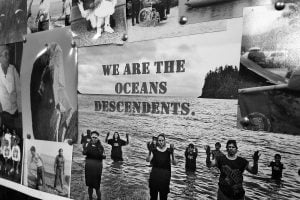
Environment
Ocean Bridge Diaries: Dax Justin
The people and landscapes of Haida Gwaii opened my eyes to the fact that we all rely on the ocean
- 1588 words
- 7 minutes
This article is over 5 years old and may contain outdated information.
Environment

As youth, our Haida Gwaii trip of a lifetime was a huge learning experience for me and the entire Ocean Bridge team. The 39 of us are in the process of becoming service leaders in our communities across Canada. We were brought together in Haida Gwaii to learn from each other, our mentors, the Haida people and others that live and work on the islands. I was part of the citizen science team, in which we worked on projects related to data collection and environmental services. Here are the projects that we were able to run in Haida Gwaii.
Scotch broom (or just broom) is an extremely invasive plant species in Haida Gwaii that is being monitored and managed by B.C. Parks. As part of our service, 20 Ocean Bridge team members went out to Misty Meadows, near Tlell, to pull Broom and get a feel for some of the work done by B.C. Parks rangers, contractors, and volunteers.
Despite a quick downpour and hail as we began pulling, we covered an area of two hectares and pulled an estimated 500 plants in just two hours! This experience was key to developing our understanding of what citizen science is and being able to start thinking of ways to implement it in our own communities.
We had Chris Ashurst from B.C. Parks come out to show us how he does long-term monitoring for intertidal species. Although we did not have time to do a full survey, which begins at 4 a.m. and collects data on tide depths and species found in the low and high tide areas, we explored with Chris and learned the methods that he would have used to do these surveys. Essentially, areas are divided into three sections and smaller quadrants are randomly dispersed over the study area. The species found within those quadrants are then tallied up and recorded for analysis.
We saw many amazing sea creatures such as anemones, isopods, chitins, and many types of sea weed. A few sea stars and hermit crabs were also around and one of our Ocean Bridgers was shocked to learn that sea stars are not always soft!
This is a huge perk of citizen science; volunteers are providing a service but also get to experience and learn amazing things that they may never have otherwise had an opportunity to learn. It is my hope that some of us from Ocean Bridge will be able to provide similar experiences to others interested in becoming citizen scientists, or at least be involved themselves. I know I will.
For our largest project, the citizen science team worked with the marine debris cleanup team to collect data while we removed plastic waste and other garbage from North Beach in Naikoon Provincial Park.
The planning stages involved developing a plan of action to conquer the menace that is marine debris. We arranged to have the beach split into sections and had data sheets to record the types of plastic found on the beach. Thirty Ocean Bridgers scoured 12 kilometres of beach and picked up hundreds of beverage cans, bottle caps, plastic bottles, and pieces of rope. Camping chairs, shotgun shells, cigarette butts, plastic bags, containers, and many other common items were also found in plenty.
It’s no surprise that plastics and other marine debris are ubiquitous in the environment; I’m sure you’d find the same at your own local beaches. The data we collected will go to the Great Canadian Shoreline Cleanup to help develop up-to-date facts and figures on the impact of plastic waste on beaches and waterways across Canada.
My experience on Haida Gwaii was an amazing opportunity for me to learn about service projects. Citizen science is all about being able to collect data using as many people as possible – many hands makes light work! – but also as a way to engage people who are not necessarily involved with science or conservation. I had a great experience during the invasive broom pull and want to find ways to do similar service projects in Vancouver. From the connections I made in Haida Gwaii and with Ocean Bridge, I know I can make that and many other service projects happen and am extremely excited as I
begin planning!
Are you passionate about Canadian geography?
You can support Canadian Geographic in 3 ways:

Environment
The people and landscapes of Haida Gwaii opened my eyes to the fact that we all rely on the ocean

Environment
Before joining Ocean Bridge, I was completely unaware of the extent of the problem of single-use plastic consumerism

Wildlife
As the sea otter begins its long-overdue return to Haida Gwaii, careful plans are being laid to welcome them — and to preserve a prosperous shellfish harvest

Environment
Bridging the gap between conservation and culture